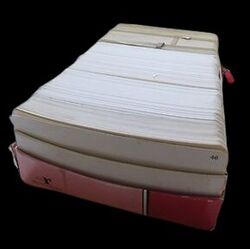| Endel Tulving's Flash Cards | |
|---|---|

| |
|
Origin |
Endel Tulving |
|
Type |
Flashcards |
|
Effects |
Melds different forms of memory into one unified retrieval |
|
Downsides |
Alteration of memories over time |
|
Activation |
Studying from |
|
Collected by |
Warehouse 13 |
|
Section |
|
|
Aisle |
857204-7820 |
|
Shelf |
148269-8663-964 |
|
Date of Collection |
May 29, 2008 |
| [Source] | |
Origin[]
Endel Tulving’s area of expertise for the last half-century has been the organization of memory. He differentiated memories into the categories of episodic, life experiences, and semantic, general knowledge. Sessions with patient KC, who lost recollection of his episodic memory after a motorcycle accident, showed perfectly fine recall of facts learned before the accident. The distinction helped neuroscientists chart why some amnesia patients could remember their childhood address with ease but not recollect an interaction within the last five minutes.
Tulving was also convinced that certain types of memories are strongly associated with different areas of the brain, such as the medial temporal lobe and hippocampus for episodic memories. Once encoded, they require an appropriate cue to retrieve the memory – such as hearing a door suddenly shut to check if the baby is asleep.
Effects[]
Filled with descriptions of the brain’s areas and their functions for the MCAT examination. Reading two different cards will combine the roles they each play in the formation of memory. Looking at amygdala alone will only incite strong emotional response of past events, but viewing with hippocampus allows for total recollection of the memory in its past context. Seems to work only in pairs or trios, nothing more.
Heavy use can result in memories becoming "tangled", with the user being unable to separate certain events. Repeated recall of specific memories can begin to alter them in seemingly random ways, from distorting the recollection or losing memories entirely in the shadow of another.
McPherson's Notes[]
"Too dangerous. Seems as though too much exposure leaves the memory like a mixed ball of play-dough, blended together into one amorphous blob. Re-asserting individual memories one by one seems to be the only way to fix this. Not advised to be used with other memory-affecting artifacts due to the fragile and unpredictable nature of the human mind. Too unreliable to be weaponized."
